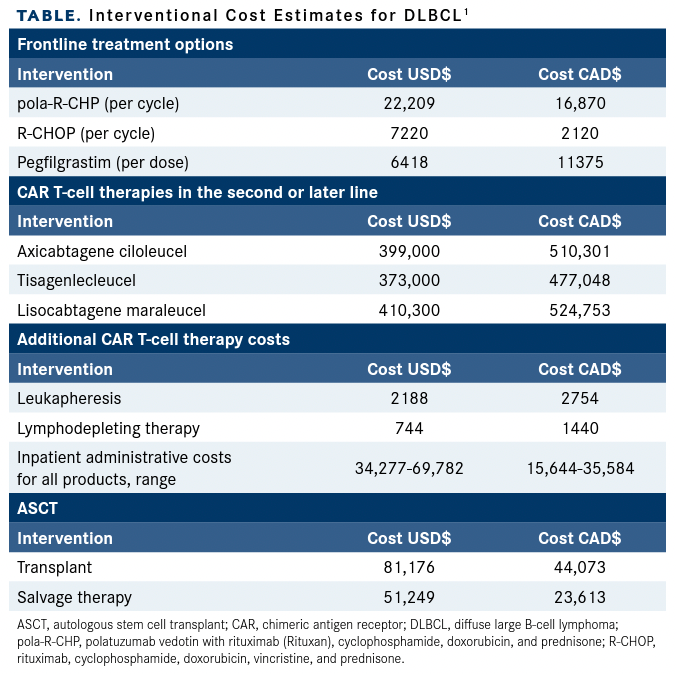Publication
Article
Frontline Pola-R-CHP, CAR T-Cell Second-line Therapies Are Not Cost-effective in DLBCL
Author(s):
An economic analysis showed that neither polatuzumab vedotin-piiq added to standard of care chemotherapy nor CD19-directed chimeric antigen receptor T-cell therapy is likely to be the most cost-effective for patients with diffuse large B-cell lymphoma.
Abi Vijenthira, MD, SM

An economic analysis showed that neither polatuzumab vedotin-piiq (Polivy) added to standard of care (SOC) chemotherapy nor CD19-directed chimeric antigen receptor (CAR) T-cell therapy is likely to be the most cost-effective for patients with diffuse large B-cell lymphoma (DLBCL). The findings published in the Journal of Clinical Oncology showed that polatuzumab vedotin with rituximab (Rituxan), cyclophosphamide, doxorubicin, and prednisone (pola-R-CHP) vs SOC and second-line CAR T-cell therapy vs SOC were not cost-effective options for patients in the United States or Canada, despite both therapies demonstrating improvements in progression-free survival (PFS).1
In 10,000 simulations, each strategy was found to be incrementally more effective than its respective SOC, but also more costly. Adding pola-R-CHP to SOC incurred an incremental cost-effectiveness ratio (ICER) of $546,956 (range, $338,797$1,199,923) US$/quality-of-life adjusted years (QALY) and $245,381 (range, $151,671-$573,250) CAD$/QALY.1
The addition of second-line CAR T-cell therapy to SOC led to an ICER of $309,813 (range, $190,197-$694,200) USD$/QALY and $303,163 (range, $221,300-$1,063,864) CAD$/QALY. Lastly, adding both pola-R-CHP and second-line CAR T-cell therapies to the SOC yielded an ICER of $488,284 (range, $326,765-$840,157) US$/QALY and $267,050 (range, $182,832-$520,922) CAD$/QALY.1
“Although there is great excitement regarding the important PFS improvements in the frontline and second-line treatments of [patients with] DLBCL reported by the POLARIX (NCT03274492), ZUMA-7 (NCT03391466), and TRANSFORM (NCT03575351) trials,2-4 this must be tempered with a realistic consideration of the costs of these therapies and their implementation,” Abi Vijenthira, MD, SM, a hematologist in the Division of Medical Oncology and Hematology at Princess Margaret Cancer Centre in Toronto, Canada, and coinvestigators wrote in the study. “On the basis of the current prices of these therapies, we found that alone or together, they were unlikely to be cost-effective from both a US and a Canadian payer perspective.”
R-CHOP [rituximab, cyclophosphamide, doxorubicin, vincristine, and prednisone] has been the SOC for DLBCL for nearly 2 decades, and autologous stem cell transplant (ASCT) has been an SOC for relapsed disease for even longer. Recently, data from the POLARIX trial showed that pola-R-CHP yielded a superior PFS benefit to R-CHOP, although a 2-year analysis did not show a survival benefit.2 Of note, polatuzumab vedotin is expensive. In the United States it is listed at $15,600 per 140-mg vial. This means a 6-cycle treatment for a 70-kg patient, which was the model used for the analysis, would cost $93,600.
Other recent developments in the DLBCL space include results of the recently published ZUMA-7 trial and the TRANSFORM studies,3,4 which compared axicabtagene ciloleucel (Yescarta) and lisocabtagene maraleucel (Breyanzi) to salvage chemotherapy with or without ASCT for patients with primary refractory or early relapse of DLBCL within 12 months of frontline therapy. Both trials showcased significant PFS benefits for these patients. However, follow-up remains short and long-term survival is still largely undocumented. As with polatuzumab vedotin, CAR T-cell therapy comes with a significant cost, ranging from $399,000-$410,300 US$, not including additional inpatient supportive care costs.1
Table. Interventional Cost Estimates for DLBCL1

The FDA approved these 2 CAR T-cell agents on April 1, 2022, and June 24, 2022, respectively; neither has been approved yet in Canada.5,6
Investigators constructed a Markov model to compare 4 strategies for patients with newly diagnosed intermediate- to high-risk DLBCL. The first strategy consisted of pola-R-CHP plus second-line CAR T-cell therapy for early relapse (< 12 months); the second was pola-R-CHP plus second-line salvage therapy with or without ASCT; the third was R-CHOP plus second-line CAR T-cell therapy for early relapse; and the last strategy was SOC, which consisted of R-CHOP plus second-line salvage therapy with or without ASCT.1
Trial data were used to estimate transition probabilities. Investigators then calculated lifetime costs, QALYs, and ICERs from an American and Canadian payer perspective. Willingness-to-pay (WTP) thresholds were designed for both populations. The WTP thresholds were $150,000 US$/QALY and $150,000 CAD$/QALY.1 In the 10,000 simulations using the American WTP of $150,000 US$/QALY, strategy 3 was the most cost-effective in 0.1% of iterations and strategy 4 was the most cost-effective in 99.9% of iterations.1
Investigators then conducted a 1-way sensitivity analysis comparing the f irst 3 strategies against the SOC. Using the range of HR reported for polaR-CHP compared with R-CHOP in POLARIX (0.56-0.95), the therapy did not represent a cost-effective strategy even for American patients when maximizing for efficacy at a 4.4% improvement. The 5-year OS improvement would need to be 7.4% for this treatment to be cost-effective.1
Of note, from a Canadian perspective, this strategy became cost-effective if the HR was less than 0.59, translating to a 5-year OS improvement of at least 4.1% with OS rates of 78.5% vs 74.4% for the therapies, respectively.
For the CAR T-cell therapies, varying the HR across the ranges reported in the ZUMA-7 trial (0.37-0.65) did not cross the WTP for either country. This meant that even if the 5-year OS improvement for second-line CAR T-cell therapy was maximized to 7.3% for a 5-year OS rate of 47.3% vs 40.0%, second-line CAR T-cell therapy would not be cost-effective over SOC in either the US or Canada. The 5-year OS improvement over SOC would need to be 9.5% or 11.3% from a US or Canadian payer perspective, respectively.1
Study authors acknowledged that the model had limitations. For instance, long-term follow-up was not available for all inputs in the model, meaning that assumptions regarding risk of relapse and probability of cure in the frontline and relapse settings had to be made. In addition, the efficacy of second-line CAR T-cell therapy has not been studied in patients exposed to polatuzumab vedotin in the front line, and so the efficacy in this setting had to be estimated. Further, CAR T-cell therapy tends to incur additional costs with inpatient supportive care, and insurance coverage is variable, making its cost difficult to estimate.1
The study authors noted that despite the short follow-up data, pola-R-CHP and second-line CAR T-cell therapies may hold the potential to alter the treatment landscape for patients with newly diagnosed or relapsed/refractory DLBCL. However, at a unique time where positive frontline and second-line trials have been reported in quick succession, funding decisions for 1 therapy may affect the cost-effectiveness implications of the other.1
“Although many drug approvals are based on PFS and overall response rate, rather than OS, health care systems must balance costs with uncertain incremental benefit,” study authors concluded.1 “Expert analysis from policymakers is required to determine the appropriateness of funding these therapies.”










